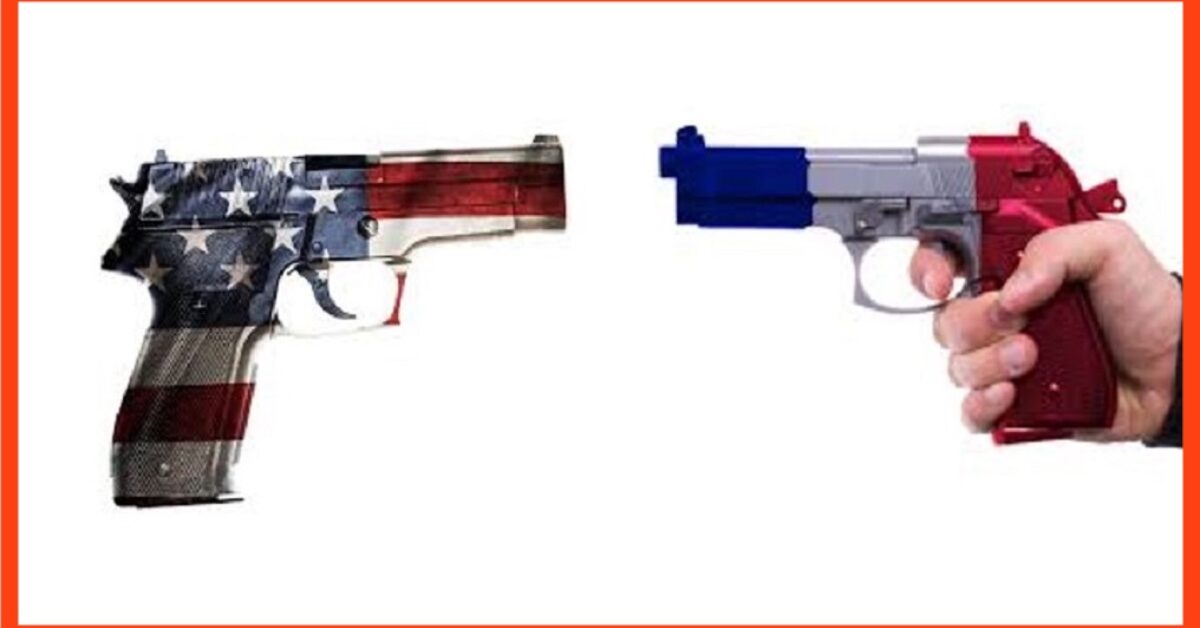Gun control: an eternal and unfortunately reoccurring debate in the United States. Waves of school shootings over the last several years have left the debate over gun control raging. Supporters of gun control have pitted themselves fiercely against pro-gun politicians and the National Rifle Association (NRA).
In the wake of the 2018 Parkland school shooting, NRA spokeswoman Dana Loesch argued (misleadingly) that “France had a higher casualty rate [from mass shootings] in one year than the entire two administrations of Barack Obama. And they’re a fifth of our population.” (Loesch cherry-picked the data: this is only correct for the year 2015 because of the terrorist attacks in France that year.) The reference to our oldest ally isn’t unique: France has been a persisting comparison point/case study in American gun control debates over the last few years, either held up as a model of success for their strict gun laws, or a failure.
Comparisons between France and the United States in this area are difficult because there are not many comparable statistics. US government-funded gun research is mostly at a standstill because of a 1996 amendment to a spending bill that forbade the Centers for Disease Control and Prevention (CDC) from using funds to “advocate or promote gun control.” The statistics we have found highlight America’s isolated position on guns, and some similarities between the two countries.
In 2013 (the most recent year for which statistics are available for France and the US), firearms killed 33,636 in the US, or 10.63 deaths per 100,000 inhabitants according to data compiled by GunPolicy.org. (In 2016, there were 38,658 deaths, or 11.96 persons per 100,000 inhabitants.) Suicides are about twice as common as homicides (6.69 deaths per 100,0000 inhabitants versus 3.54 deaths per 100,000 inhabitants).
France, on the other hand, is about average with other advanced countries, with 2.65 deaths per firearm per 100,000 people in the same year. The gap between the rates of suicides (2.09) and homicides (0.22) is much wider than in the US. According to The New York Times, based on data from the CDC compiled between 2007 and 2012, an American is as likely to be killed by a gun as a Frenchman is likely to die of hypothermia.
It’s a reality that is also reflected in the recurrence of mass shootings (which are defined by more than three or four deaths, excluding the shooter). Between 2000 and 2014, there were 133 mass shootings in the US and only one in France. Three of the five deadliest killings in US history have taken place in the last 18 months (Las Vegas, 58 dead; Orlando, 49 dead; Texas, 26 dead).
Moreover, the trend is reversed between the two countries. While the US has been loosening gun laws around background checks and concealed carry, France has implemented measures to limit import, circulation, and access to firearms. The result: the US represents 4.4% of the world population but holds 42% of all civilian arms. In 2013, there were 357 million civilian firearms in circulation in the US, according to figures published in The Washington Post. For a population of 317 million, this means that there are 101.5 weapons per 100 inhabitants. On the other hand, in France, the number of firearms has drastically decreased: from 19 million firearms in 2006 to 10 million in 2016 (i.e., from 31.2 firearms per 100 inhabitants to 14.96). The US is number 1 in the ranking of firearm ownership while France does not break the top 10.
Several studies confirm that there is a direct correlation between the number of weapons in circulation and the number of deaths (homicides and suicides) in the US. Every time the number of firearms per capita increases by 1%, the homicide rate per firearm increases by 0.9%. The correlation is even more evident when looking at other developed countries as well as the differences between pro- and anti-gun American states.
The correlation is also particularly true when looking at suicide, which accounts for the largest share of firearm deaths (about 60%). While the number of suicides by firearm decreased by 47% in France between 1997 and 2013, it increased by 28% in the US over the same period. Again, data shows that access to firearms has a direct impact on the number of suicides. Suicide is the second leading cause of death among 15-34-year-olds in the United States.
Frequently Asked Questions – Gun Laws in France vs U.S.
Can you legally own a handgun in France?
French people can legally apply to own a handgun if they have a hunting license, but it must be regularly renewed and requires a psychological evaluation.
What percent of France owns a gun?
An estimated 1.6% of French people own guns, the majority of them being hunters.
Do French police carry guns?
French police sometimes carry guns, but generally only in high risk scenarios. Lower level cops are far less likely to carry firearms.
*This article was originally published in February of 2018.






